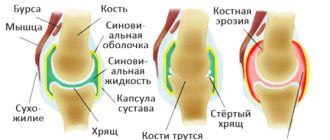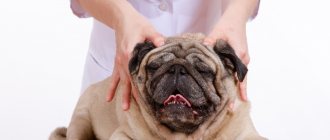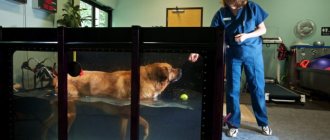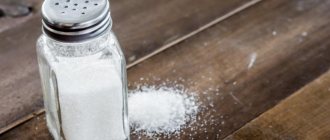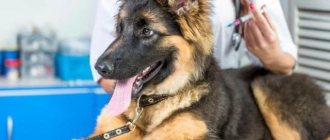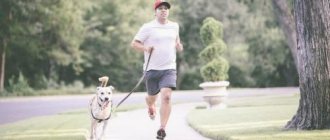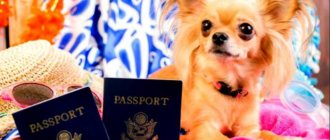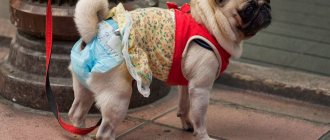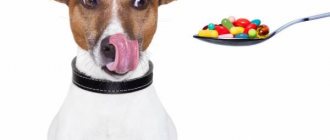Massage has a preventive and therapeutic effect on the human body. But not only people have noticed a positive effect. Massage for animals also has a beneficial effect on the body system and the condition of internal organs. Today we’ll talk about massage for dogs. This procedure is an excellent addition to the main treatment, which promotes faster recovery of a weakened body.
Back in Ancient Greece, they began to practice massage treatments for animals. The philosopher Arrianus argued that the animal becomes much healthier and more resistant to the development of various diseases.
Today, many pet salons offer this service. And this is not at all surprising, since in many health situations massage can become an additional, and sometimes the main treatment for various diseases.
Massage will help the dog calm down and feel cared for by the owner.
Causes of limb problems
There are many causes of musculoskeletal diseases in dogs. These are injuries, untreated infectious diseases, excess weight, metabolic disorders, poor quality nutrition, excessive physical activity, etc.
All these factors provoke the development of chronic diseases that require high-quality, timely treatment.
Damage
Mechanical injuries that can damage motor functions: fractures, tendon ruptures, sprains, nerve damage. They can occur due to strong impacts, falls from great heights, or bites from other animals.
Arthrosis
Arthrosis and arthritis are inflammatory diseases of the joints. If left untreated, they are characterized by severe pain and the dog’s inability to move independently.
Tumor
Neoplasms in the tissues of the paws or spinal column impair blood circulation and innervation of the limbs, which leads to insufficient nutrition of tissue structures and their subsequent degeneration.
Vertebral degenerative diseases
They are characterized by metabolic disorders in the tissues of the spine and subsequent degenerative changes in its structures.
Spondylosis
A disease of the spinal column characterized by a chronic course. It manifests itself as a spiky growth of bone tissue along the edges of the vertebral bodies.
Because of this, the lumen of blood vessels in the spine decreases, which impairs the nutrition of tissues and causes their degeneration, and has a negative effect on the nerves and tendons in the damaged area. Accompanied by severe pain.
Osteochondrosis
The disease manifests itself in the form of degeneration of cartilage tissue, usually in the intervertebral discs. Leads to acute pain, deterioration of blood circulation and innervation of the limbs.
How to massage a dog
Of course, professional massage is only possible for specialists in this field. We suggest you familiarize yourself with how to perform a regular massage, which every dog owner can do.
- So, the simplest and most accessible massage is stroking the sides, belly and back.
- Next, you need to grab the tail with your palm and stroke it from the root of the tail to the tip.
- Then you need to lightly tap the skin with your fingertips.
- Some dogs, and in particular the Italian greyhound, love to be touched with a silk scarf.
- Having finished with soft elements, you can move on to more intense ones. Using rake-like movements of your fingers, you need to stroke from the stomach to the back. The dog must stand while doing this.
- Next, the dog should take a lying position. You should make circular movements with your palm, moving against the muscles.
- Afterwards, you need to gently rub the dog’s paws, as well as the area between the pads.
- The procedure should be completed by general stroking of the entire dog.
Relaxing massage for dogs
Before starting the procedure, you need to prepare yourself and your pet. Take a few slow breaths and shake your arms. Gently stroke your animal and talk to it in a quiet voice.
Using your fingertips, gently make circular movements along the muscles of the spine. Perform circular movements first clockwise, then counterclockwise. During movements, fingers should not leave the animal's skin. Then use the same circular movements at the base of the skull. Once you feel the animal relaxing, you can slowly move to the front of the neck. The trachea and muscles on both sides of the pharynx should be avoided. Slowly move to the base of the ears
The area under the ears should be massaged very carefully because the lymph glands are located there.
Such joint massage procedures will be useful for the pet and its owner: the person will lose stress, aggression, nervousness, blood pressure will decrease, and the dog will feel care and love from its owner.
The information provided will help dog owners understand how to properly massage their pet. And also find out the reasons that lead to weakening of the hind legs of animals.
Helping the dog relax
A relaxing massage for dogs is essential to calm the nervous system and relieve stress. This procedure is useful to do when your pet is frightened by something or after a hard day. In this case, the main attention should be paid to the area of the head, ears and back.
Follow the following sequence:
- Pet your pet's entire body. At the same time, try to speak kindly to the dog. Pat the dog by the scruff of the neck. This will help the animal calm down and relax.
- Start the massage from the neck. Massage the area in a downward circular motion. Do not press too hard, remember that there are many blood vessels in this area. Massage the ears and the area around them, but very gently.
- Then move to the shoulder girdle. Make the same circular movements. Gradually move towards the tail.
This completes the procedure. Finally, you can stretch the ponytail a little or turn it three times in different directions. But watch your pet's reaction. Some dogs find such manipulations relaxing, but not all dogs like having their tail touched.
Causes of weak paws
- Damage to limbs.
Diseases of the hind legs can occur due to injuries: fractures, sprains, tendon ruptures, damage to peripheral nerves. Bites from other dogs can also be a cause; in a fight, bruises or falls, the dog can (slip on ice). - If the animal suffers from arthrosis, arthritis, tumor
, also with herniated intervertebral discs. A spinal pathology may develop in which there is a disruption of the innervation of the limbs when the spinal cord is exposed to negative factors. - Vertebral degenerative diseases
. These diseases begin due to improper functioning of the metabolic processes of spinal tissue. This can lead to pathologies of the constituent links of the spinal column. - Spondylosis in dogs.
Leg failure is associated with “local aging” of certain segments of the spine. Usually the disease itself has a slow rate of development. The first stage is invisible and almost impossible to detect. - Osteochondrosis.
Degenerative stages of intervertebral disc development occur.
The reasons for the development of this disease can be vertebral instability, which develops at the genetic level. Rheumatic disorders, previous back injuries, impaired disk nutrition due to microcirculation disorders, autoimmune phenomena.
Massage of hind and front paws
Before the procedure, the pet is placed on a comfortable bed. The purpose of massaging the hind and front paws is to relax the animal, improve blood flow and relieve muscle tone.
The dog’s front paw is taken in the hand and the fingers are lightly squeezed; they are held in this state for up to a minute. After this, each pad is gently moved up and down. The procedure is repeated with each paw.
After the fingers, they begin to massage the tendons of each leg. After this, the upper part of the limbs (thigh, shoulder) is rubbed. Finish this massage by carefully bending each joint.
Massage for sports, working and show dogs
Indications for manual therapy for sports, working and show dogs:
- preparation for training and competitions;
- recovery after exercise;
- relieving excessive muscle tension, which also impairs the dog’s athletic qualities;
- relaxation and improved contact with restless animals, including in preparation for exhibitions.
Massage is a great way to help dogs stay in great shape. In addition to relaxation after competitions or training, which helps muscles recover faster, massage and stretching are also included in the program of competent preparation for stress, improving joint flexibility and coordination of dogs.
Technique
The procedure for massaging your dog’s hind legs can be done at a veterinary clinic or you can master the technique yourself. Choosing the latter option does not cancel the obligatory visit to the veterinarian, who will assess the pet’s condition and prescribe appropriate treatment, which may include massage, medications, or a combination thereof.
There will be much less stress for your pet if the necessary massage manipulations are carried out by a person you already know, taking care of him. However, to earn trust, all movements must be weak at first. Gradually you need to move on to more intense actions, since it is impossible to achieve a positive result with light stroking. The recommendations below will help you figure out how to do everything right and benefit your pet. But if there is not enough time, energy and desire for a high-quality procedure, it is better to entrust its implementation to specialists.
Preparatory stage
It is recommended to carry out the procedure 30 minutes after feeding the dog, choosing the same time every day, a quiet place familiar to the animal, without external stimuli. To place the “patient” you should prepare a flat, slightly soft surface. Blankets and pillows should not be used for this purpose.
An important condition for the comfort of a pet is the warm hands of the owner.
Procedure at the preparatory stage:
- Lay the dog on its side and stroke the body from head to tail with light movements of a wide open palm. For additional relaxation, you can complement your actions with gentle words. Over time, you can slightly increase the pressure on the body so that the movements resemble rubbing.
- Massage your back in the direction from the shoulders to the base of the tail, working each muscle. It is strictly forbidden to massage the spine and bone formations.
- Rub the sacral area with light circular movements of the open palm.
- Pat your belly. If the dog experiences noticeable discomfort during this manipulation, you can do without it.
- Give a head massage. To do this, place your palms on the sides of the skull, slowly moving them back and forth. For small pets, actions can be performed with your fingers.
- Walk your hands several times from the base to the tip of the tail, squeezing it lightly. It is forbidden to pull or put too much pressure on the tail: discomfort can provoke the pet to make sudden movements, which is fraught with additional injuries (for example, to the spine) and loss of trust on the part of the dog.
Limb massage
Provided you are completely relaxed at the first stage, you can directly begin to massage the hind legs. The manipulation technique will be as follows:
Take the paw in your hands and stroke the entire surface from top to bottom and from bottom to top several times
To improve blood circulation, over time you can increase the intensity of movements in order to massage the limbs strongly enough, but without unpleasant sensations for the animal. Grasp the base and tip of the limb with both hands and do light movements 10-15 times, without sudden movements, flexion-extension, paying special attention to the pet’s reaction. If there is noticeable discomfort and painful reaction, the range of motion and number of repetitions should be reduced. Make circular rotations with your paw in the hip joint
Movements should be clockwise and counterclockwise, up to 5 times in each direction.
- Stretch all the muscles of the limb with three fingers (index, middle and thumb), spending at least 1-2 minutes on each area.
- Apply pressure 20-30 times on the pads of the dog’s toes, clasping the end of the paw with your hands.
- Massage the spaces between the fingers.
The final stage of the massage can be stroking movements throughout the body, which will especially help calm a restless pet.
For reference: aquamassage is sometimes used as an additional procedure, when the dog is placed in a container with warm bubbling water for 10-15 minutes. Hydromassage waves stimulate blood supply processes, tone skeletal muscles and help relax the animal.
Relaxation massage complex for your beloved dog. Instructions
When I read or watch a movie where there are scenes of the luxurious life of four-legged pets, I am not impressed by the diamond collars and couture carriers costing tens of thousands of dollars. But I am always pleased to look at various spa treatments and understand how wonderful the celebrity clients feel at this moment.
But you can provide your pet with a pleasant massage without having millions of bills and a personal massage therapist.
This will require a little skill and time, which will more than pay off in the tender feelings of your pet and the improvement in the well-being of your four-legged friend, including yours.
Believe me, tactile contact with an animal has such a beneficial effect on a person that it is not even necessary to cite research data on this topic. Simple massage movements with your fingers or palms create incredibly pleasant sensations for both the dog and its owner. And how does this strengthen the emotional connection between you!
Dogs are just as susceptible to stress as people. They, like people, cannot relax, this negatively affects not only the muscular, but also the cardiovascular and nervous systems. As a result, various diseases occur in your beloved four-legged friends.
As a veterinarian, I know how much patience, attention and care a dog owner puts into his beloved pet. But the question of how often you massage your dog often confuses the owner. Of course, there are those who massage regularly, and this is commendable, but mistakes also happen when the technique leads the dog to a more excited state.
Before we begin describing the relaxation massage technique, I want to give some tips.
Tip 1
Before you give your dog a relaxing massage, relax yourself! Dogs perfectly sense the emotional state of their owner. What can we say about touches in which the contact is maximum! Your state at the time of massage is much more important than technique, so the main condition for an effective relaxing massage is your calm, balanced state.
Tip 2
The massage should also be carried out at a calm pace, slowly, paying attention only to what is happening. Switch off for this time from the daily bustle, forget about problems and affairs - focus all your attention on simple repetitive movements.
Tip 3
If you don’t have the desire to master even very simple techniques, that’s also not a problem.
Just slowly make circular movements with your palms over the entire body of the dog, paying special attention to the large muscles of the back, also work the hips, sides and neck.
Relaxation massage complex (simplified version)
There is no specific time for a relaxation massage. It can be used as needed. Ideal for establishing personal contact. If you feel that the dog is tense and anxious, perform a small complex of such massage; it takes only 10-15 minutes. But if you realize that this is not enough, you can increase the massage time. There will be no harm from this. And the relaxation effect will increase. You can also use it before shows, before or after travel. Just feel this moment when your pet is tense.
The whole complex consists of 5 components:
- Light movements in the upper neck area. Circular, calm movements without much pressure.
- In the neck area, down along the back to the sacral area, we carry out light stroking.
- Now massage the sacral area
- Let's move on to the tail massage.
- Using light strokes, move to the neck area.
- Finally, carry out a flat stroking of the body and finish with a light stroke.
As you can see, to conduct a relaxing massage you need to master various massage techniques (methods). To begin with, we will master only a few, those. what is needed for this complex. Read the text carefully and look at the picture.
Light stroking.
This is the main technique of relaxation massage. This method of massage has the most powerful relaxing, calming effect, one can even talk about a slight sedative effect, since the effect is on the central nervous system. The main thing here is to massage at a slow pace, about 10-20 movements per minute.
Light stroking is carried out along the muscles with slight pressure, superficially, with fingers or palms.
Plane stroking.
Planar stroking is usually started after light stroking.
This technique has a beneficial effect on the outflow of fluid and stimulation of blood circulation.
Massage should be done in the direction of the heart
Planar stroking is carried out in a sliding manner, and the degree of pressure should be constant at all times. But the use of your hands can be chosen at your discretion, there are no clear instructions here, so use only one hand if it is comfortable for you, or massage with two, or you can use your hands alternately.
Strengthen the muscles and release pressure while massaging the ligaments and bones.
Maintain a constant speed of movement with your hands, approximately 15-20 movements per minute, contact with the surface of the dog’s body should be constant, unbroken, the hand should follow all the bends of the body. Work with your whole palm.
Vibration
The effect of this technique is clear from the name. I recommend using point vibration, which is performed with the thumb or the tips of the other fingers. Vibrate as gently as possible in a calm, measured rhythm with slight pressure, thereby causing pleasant oscillatory movements. Vibrate for a few seconds and stop. Repeat, increasing the pressure. To enhance the relaxation effect, alternate vibration with light stroking. Can be used in conjunction and flat stroking. The pressure should not be strong, then the neuro-reflex effect will be maximum. A very pleasant and effective technique. Causes relaxation of the nervous system and is used to affect deep-lying muscles.
Pressure
This technique is recommended only for large breed dogs. It can be performed in two different ways: palm pressure and fist pressure.
How to massage the sacral area
For 10-30 seconds , apply vibration using your right hand to massage. And then move on to circular movements , perform them slowly counterclockwise.
How to perform a tail massage
The massage is carried out as follows: Place your left hand in the sacrum area, and with your right hand apply very light pressure along the caudal vertebrae. When finished, move to the sacrum. Next moment, use your right hand to lift your tail slightly up. Bend your tail into an arch using both hands. Now you can move your tail in a circle, several times clockwise. And then counterclockwise. You can pull the tail, but do this with extreme caution and only if the dog allows you to do so. This technique has an incredible relaxing effect. But you need to do it no more than a minute.
Can be supplemented with vertebral massage. Finish stretching the tail by stroking the back of the body for a short time.
Conclusion.
As you can see, mastering several massage methods is not difficult. The technique is simple. but effective. When performing a massage on your pet, you will certainly want to continue and explore other massage methods...
Marina Sizova, head physician of the Roki clinic
Massage for weak hind legs
The sooner the dog owner pays attention to the condition of his pet and takes him to the veterinarian, the higher the rate of recovery. The doctor will conduct an examination and prescribe the treatment necessary in this case.
He will also prescribe a massage for your pet.
Massage can be done in a clinic, or you can learn it yourself. The doctor will show and talk about the procedure. And your pet will be much more pleasant if you are the one who carries out this procedure, devoting your time to him and showing him care.
So where to start:
Prepare the place where you will do the massage. Cover it with a warm blanket. Warmth makes it possible to relax. Lay the dog down and say a few kind words. Start the massage with light, stroking movements of the whole body, without lifting your hands
This will relax the animal. After massaging and stretching the dog’s entire body, smoothly move to the hind limbs. Gently take one paw in your hands and perform several strokes from top to bottom. Then stroke the same way, only from bottom to top. Next, holding the paw, carefully perform several flexions and extensions. After this, make circular movements inward, then outward, then forward and backward. These exercises need to be repeated 2 - 3 times. Using three fingers (index, thumb, middle), rub the muscles on the limbs. After this, start massaging the ball of your pet's foot and toes with your fingers.
Start with minimal pressure, then increase it a little. There is no need to press hard. Finish the procedure by stroking the paws and pads, paying attention to the places between them. All this must be repeated with the second paw. After everything you have done, carry out a general stroking of the dog’s entire body.
All these massage movements will eventually help restore the dog’s paws and he will regain strength in them. If the disease is not associated with a more serious cause.
Take care of your pets and be happy!
Massage has a preventive and therapeutic effect on the human body. But not only people have noticed a positive effect. Massage for animals also has a beneficial effect on the body system and the condition of internal organs. Today we’ll talk about massage for dogs. This procedure is an excellent addition to the main treatment, which promotes faster recovery of a weakened body.
Back in Ancient Greece, they began to practice massage treatments for animals. The philosopher Arrianus argued that the animal becomes much healthier and more resistant to the development of various diseases.
Today, many pet salons offer this service. And this is not at all surprising, since in many health situations massage can become an additional, and sometimes the main treatment for various diseases.
Massage will help the dog calm down and feel cared for by the owner.
Pet massage
Contents hide
Pet massage is a sensory technique used to maintain and improve the physical and mental health of our pets. Massage for tailed animals has become popular relatively recently, but its positive effect on the condition of animals is already noticeable. As an alternative medicine, it provides them with additional resources for wellness and a happy life, and can help prevent injuries and promote speedy recovery. During a massage, your pet's body releases endorphins (better known as "happy hormones"), which are a natural chemical that relieves pain and elevates mood.
One of the advantages of massage for animals these days is its accessibility. Today, this practice is no longer a luxury for rich and famous hosts. Thanks to a variety of educational resources and, of course, consultations with veterinarians, any owner can carry out harmless and simple manipulations that are beneficial for the pet. Taking into account the doctor's advice, massage can be done on an animal of any age. In addition, you don’t have to resort to massage only in case of illness - for healthy pets it serves as an excellent preventive measure.
The main reason why veterinarians recommend massage is the similar processes in the human and animal bodies. Indeed, the blood circulation and nervous system of pets are similar to ours, which means that the benefits of massage that people see for themselves are quite relevant for animals. The most common “clients” of massage therapists are dogs, cats and horses.
Since 2000, there has been an International Association of Animal Massage and Bodywork, whose experts claim that massage improves blood and lymph circulation, improves immunity, promotes good digestion (which is especially important for overweight pets), healthy appetite and good sleep. Just like people, it helps pets relieve muscle tension, stiffness and pain, so owners of older animals or, conversely, young and overly active animals should pay attention to this practice. Massage is often used to solve problems with a pet’s mental health, correct behavior and temperament: it calms aggressive, nervous and hyperactive animals, and helps shy and fearful pets feel more relaxed and confident. The act of touch itself often brings about emotional healing and a sense of security in the pet. Finally, the most obvious use of massage is for the recovery of pets after injuries and surgeries, as well as the relief of symptoms of chronic diseases, such as arthritis.
Despite the many positive benefits of massage, there are situations in which it may not be suitable. Here are some of them:
— Fever, exhaustion, poisoning
— Infectious diseases, rashes, open wounds
— Some heart and cancer diseases
– Low blood pressure, thrombosis
- Any disease not diagnosed by a veterinarian
Remember that before massage sessions you should always consult a doctor and identify possible risks in advance. Once you are sure that your pet really needs help of this nature, you should decide who will do the massage - you or a professional. The choice depends primarily on the purpose (prevention or treatment) and the nature of the disease. There are a number of different techniques used in pet massage, including classic Swedish (working on deep tissue), sports (focusing on flexibility and injury prevention), and hydrotherapy (involving the use of water). If you decide to entrust your pet to a massage therapist, familiarize yourself with the qualifications of this specialist in advance and try to ask him questions about work experience, education, specialization, and also ask for feedback from other clients.
Of course, choosing a certified veterinary massage therapist is the best option, but that doesn't mean your pet can't enjoy a simple at-home massage. You just need to familiarize yourself with the rules and techniques in advance. First, try to choose a time when your pet is relaxed and calm, and don't start immediately after vigorous play. Second, find a quiet, comfortable corner in your home. Place a rug or towel on the floor for added comfort. If your pet is not afraid of musical accompaniment, turn on a calm composition, for example, classical music, sounds of nature or the sound of the sea. Third, massage should be done on the animal's terms. What does it mean? For example, the process itself can last from ten minutes to an hour, but in the end the pet itself will tell you when it has had enough. Let your dog or cat decide which position is most comfortable for them. The pet can lie down, sit down or even stand up.
Unless you're trained in massage, experts recommend avoiding advanced techniques and focusing on the basics. Carefully monitor your pet's reaction and do not force unpleasant actions on him. Touches should be gentle and as careful as possible. This is especially true for cats - they generally prefer a “softer” massage than dogs. It is recommended that you begin the massage with slow, gentle strokes along your pet's body to release tension. The amplitude of movements depends on the size of the animal. Don't forget about the muzzle, head, neck and ears - if the pet doesn't mind, they can also be massaged. Use light circular motions around your pet's face, then begin massaging the front and rear legs using gentle squeezing. It is very simple to determine the impressions of an animal: a relaxed pet may doze, drool, sniffle and purr.
Home massage not only has a positive effect on the health of animals, but also allows them to get as close as possible to their owners, establish friendly relations and strong affection.
Photo source: www.pixabay.com
Adviсe
An owner who wants to learn how to massage their pet should familiarize themselves with some basic recommendations:
- Before starting manual therapy, learn the basics of canine anatomy and physiology. You can research this yourself online or ask your veterinarian;
- Spend 10 minutes daily massaging a healthy dog. This way, her muscles and joints will remain in good condition - in old age there will be no problems with limb atrophy or pain. She will also be happier and more content;
- First, crumple one side of the pet, then transfer it to the other. Do not touch the stomach at all or just stroke it lightly - otherwise you can damage the internal organs;
Abdominal massage should be done last.
Video - How to massage a dog's shoulders
No matter what problems you have with your dog, most often you need to solve the same question - how to calm your dog
. The fact is that aggression, tightness, depression, constant barking, fears, excitement - all these seemingly different manifestations of emotions are most often caused by one factor: the dog is tense. And if you can relax her physically, you will immediately notice a change in her behavior.
People often underestimate the connection between a dog's muscle relaxation and his behavior. If the dog is relaxed and has no tension in its muscles, then it will not become aggressive, rage, jump, or, conversely, tighten or hide.
This is why it is so important to ensure that your dog learns to relax every day. It will take several weeks for dogs to acquire relaxation skills, depending on the degree of initial tension.
Preparing your dog for a massage
Before the procedure, the animal must be prepared and one of the requirements is clean fur. Therefore, if possible, the pet is bathed with shampoo, or the fur and paws are cleaned with wet towels and napkins.
It is not recommended to feed the animal 2-3 hours before the procedure and to walk the animal before the procedure so that it does not experience anxiety and discomfort from the desire to relieve itself instead of relaxing.
For aggressive animals, the procedure is carried out only if they have a muzzle. By the way, some clinics and salons charge a premium for a dog’s aggressive behavior.
Contraindications to massage
It is important to remember that this is a medicinal thing, so it has contraindications. These include:
- eczema;
- purulent infections;
- neoplasms;
- open wounds;
- increased body temperature;
- bleeding;
- epilepsy;
- inflammation;
- state of shock;
- fresh fracture with pain.
Be sure to consult your veterinarian before performing a massage.
Attention! If you have at least one item from the list, do not touch your pet! Even if there are no contraindications, it is still advisable to consult with a veterinarian before starting sessions - he will tell you what exactly is right for your animal and teach you the basic techniques.
Massage for weak hind legs
The sooner the dog owner pays attention to the condition of his pet and takes him to the veterinarian, the higher the rate of recovery. The doctor will conduct an examination and prescribe the treatment necessary in this case.
He will also prescribe a massage for your pet.
Massage can be done in a clinic, or you can learn it yourself. The doctor will show and talk about the procedure. And your pet will be much more pleasant if you are the one who carries out this procedure, devoting your time to him and showing him care.
So where to start:
Prepare the place where you will do the massage. Cover it with a warm blanket. Warmth makes it possible to relax. Lay the dog down and say a few kind words. Start the massage with light, stroking movements of the whole body, without lifting your hands
This will relax the animal. After massaging and stretching the dog’s entire body, smoothly move to the hind limbs. Gently take one paw in your hands and perform several strokes from top to bottom. Then stroke the same way, only from bottom to top. Next, holding the paw, carefully perform several flexions and extensions. After this, make circular movements inward, then outward, then forward and backward. These exercises need to be repeated 2 - 3 times. Using three fingers (index, thumb, middle), rub the muscles on the limbs. After this, start massaging the ball of your pet's foot and toes with your fingers.
Start with minimal pressure, then increase it a little. There is no need to press hard. Finish the procedure by stroking the paws and pads, paying attention to the places between them. All this must be repeated with the second paw. After everything you have done, carry out a general stroking of the dog’s entire body.
All these massage movements will eventually help restore the dog’s paws and he will regain strength in them. If the disease is not associated with a more serious cause.
Take care of your pets and be happy!
Symptoms of hind leg problems
Sometimes it happens that your pet cannot move normally as before. You notice that his limbs are weak. There are breed and age predispositions to specific pathologies.
- The first symptom is pain when walking. Your pet suddenly begins to moan. Neurological disorders begin to occur in the dog’s thoracic and lumbar spine.
- Next comes weakness. The animal stops moving its paws.
- Then the sensitivity of the paws disappears.
This can happen suddenly while you are walking your dog, or at rest for no apparent reason. Physical activity can cause pain. But it is not the main cause of the disease itself. This disease can appear suddenly.
Only in the morning everything was fine, but by the evening the dog could not move normally. Or it can develop gradually, from the first symptom some time may pass until the last.
Many animal lovers think that this disease depends on the length of the dog's spinal column and plays a role in the onset of the disease. This opinion is wrong. Here are several reasons why this disease may develop.
Complications during childbirth
Even normal childbirth is a difficult and exciting process. Unfortunately, sometimes complications arise that make it completely dangerous.
Weak labor
Too weak contractions and attempts can appear both immediately with the onset of labor and after the birth of, for example, three puppies. This happens in weakened dogs, emaciated or, conversely, overweight, deprived of the necessary physical activity, and in old age. Another reason is the presence of a hernia - it must be removed no later than 6-7 months before mating.
What to do in this situation:
- Give the bitch an injection of ascorbic acid intramuscularly - 2-3 ml. Also intramuscularly – 10 ml. calcium gluconate. After this, try to enhance labor with massage.
- Using light pressure, move your hand from the dog's head to the tail. Feeling the push, move your hand after this muscle wave, as if helping and strengthening it.
- Using circular movements, massage the tail at the base.
- Lubricate your fingers with rich cream and massage the area of the body from the anus to the loop.
- Insert one finger, lubricated with a greasy disinfectant ointment or Vaseline, into the loop, massage the vagina from the inside, stroking its walls. It’s good to lightly massage your dog’s belly at the same time.
- Express some colostrum from the mammary glands - this stimulates uterine contractions.
If after these measures the first puppy is not born, consult a doctor immediately! A caesarean section will most likely be required.
If labor weakens after the birth of several babies, give an injection of oxytocin: 1 ml. intramuscularly. A second injection is given after a couple of hours, provided that after the first injection the puppy was born. If this does not happen, call a doctor. At best, this means that labor is over; at worst, it indicates the need for surgery.
The vaginal walls are not elastic
This is a problem for many primiparous dogs. She disappears with the arrival of the first puppy, but he needs help. To do this, insert cold sterile Vaseline oil into the vagina, slightly stretching the walls with your fingers.
If this does not help, try to carefully grab the puppy by the skin and, using gentle movements that coincide with the rhythm of the contractions, direct him towards the exit. The appearance of the first child in this way will be very painful for the dog, he may squeal loudly
Dry birth
It happens that the fetus begins to come out only a couple of hours after the water breaks. Due to this long gap, the vagina is deprived of natural lubrication, and mucous tissue may be damaged. To avoid this, insert petroleum jelly into the vagina.
Dead, large or abnormally walking puppy
Even if labor is normal in strength, it happens that the baby cannot be born. It can be too big, or it goes sideways, or it doesn’t move at all. First of all, make sure that he is not actually moving forward. Insert a clean, Vaseline-smeared finger into the vagina, feeling for the puppy. After a quarter of an hour, repeat the procedure.
Retained placenta
Be sure to make sure that the number of afterbirths matches the number of births. If the placenta does not come out within 5 hours after birth, you need to give an injection of oxytacin (1 ml.). After this, massage your dog's belly with a warm shower. The dog must stand at this time.
Puppy stuck
It happens that a newborn, half out of the loop, gets stuck, squeezed into a ring. Do not try to pull it out by force - this will harm both the baby and the mother. The spasm will be relieved by an injection of no-shpa - 1 ml intramuscularly.
Narrow pelvis
The reason for the narrowness of the pelvic opening is the dog’s underdevelopment in childhood: rickets, other diseases or poor nutrition. In most cases, she needs a caesarean section to give birth. It makes more sense to avoid breeding an animal with such a problem.
Anatomy of the back muscles in dogs
The back muscles include the muscles of the spinal column - the cervical, thoracic, lumbar and caudal regions.
Almost all of these muscles belong to the dorsal muscles of the spinal column - that is, they are attached to the vertebrae from the back. Only some muscles of the neck are attached ventrally (from the abdomen), which perform the function of turning the neck to the sides.
The back muscles are formed by several layers of muscles.
The superficial layer of the neck and back muscles is formed by the splenius capitis muscle. It runs from the level of the atlas wing (the first cervical vertebra) to the spinous processes of T3 - T4 (thoracic vertebrae). With its participation, bending of the neck, raising and straightening of the head occurs. It is partially involved in the rotational movements of the neck.
The middle layer is formed by the iliocostalis and longissimus muscles. These two muscles completely fill the space between the spinous and transverse processes of the vertebrae from the occipital bone to the sacrum. The longissimus muscle, depending on the place of attachment, can be divided into sections - the longissimus muscle of the head, neck, chest, and lower back.
The deep layer includes the semispinalis and spinalis muscles and the multifidus muscles. The multifidus muscles are multi-layered, connecting every two vertebrae in series, the next layer connecting the vertebrae through one (the first and third), and another layer connecting the vertebrae through three (the first and fifth).
The muscles of the back also include short muscles - the intertransverse, interspinous and rotator cuff muscles.
The most mobile areas in dogs are the cervical and lumbar regions. The thoracic spine is less mobile, limited in the amplitude of flexion and twisting, the vertebrae are additionally stabilized by the ligamentum flavum. Therefore, most often injuries or disease of the intervertebral discs are diagnosed in the cervical or lumbar regions.
For the muscle group that rehabilitation therapists or athletes work with, there is a collective name “paraspinal muscles”. This group includes the multifidus, semispinalis and spinalis muscles, and partly the longissimus muscle. Exercises for the cervical spine are discussed separately.
Types of massage for dogs
Veterinary clinics create individual massage programs, depending on the pet’s health status, breed, and weight. But the most common types are:
Therapeutic and health massage for dogs, which is given to animals with arthritis, arthrosis, osteochondrosis, dogs after fractures, sprains, hematomas, dislocations.
Preventative is performed using various techniques in order to relax the muscles and increase their tone. For example, dog athletes receive a warm massage to relieve muscle tension.
Rare, but provided in some pet salons, is aquamassage for dogs. This procedure is considered therapeutic. Boiling water has a healing effect. The animal is placed in a small bath with hot bubbling water, the water streams have a relaxing effect on the muscles, aqua massage increases tone, increases the mobility and elasticity of the joints, and improves blood circulation.
In spa salons, animals are given massages using cosmetics, in particular aromatherapy. Cosmetics, such as sea salt, fortified powders, aromatic oils, are applied to damp hair and rubbed in with light movements. Then the cosmetics are washed off with water. The products strengthen and add shine to the coat, relieve static tension, and normalize blood circulation.
Some techniques are aimed at correcting the dog’s behavior, for example, at making the pet calmer and getting rid of the habit of barking and gnawing.
Elite care
The salon's masters use natural cosmetics containing vitamins, plant extracts, algae, fruit acids, liquid oils, and medicinal mud. Active ingredients tone the outer skin, strengthen and nourish the coat, prevent hair loss, dryness and brittleness. In addition, your pet’s “hair” will be protected from the negative effects of ultraviolet radiation and temperature changes.
SPA cosmetics are selected individually according to the dog's breed and coat type. Together with massage, masks help the dog feel calm and peaceful, making its fur smooth, shiny, fluffy and not prone to tangling or matting. They are also applied to the body of dogs with short hair or even hairless pets, like the Chinese Crested. Ozone therapy saturates the cells of the skin and other organs with oxygen, has a bactericidal and anti-inflammatory effect.
Types of massage for dogs
Typically massages are divided into:
- execution technique - point, segmental, classical, visceral, osteopathic;
- effects on the body - preventive, restorative and therapeutic;
- method of influence - manual, hardware.
Sports massage is also worth mentioning. The term itself, as well as the type of procedure, has become widespread since the 1970s of the 20th century. It began to be used in equestrian sports to improve athletic performance and maintain good physical condition of horses.
Did you know? The first known treatise on massage was written in 2700 BC. e. in China.
The newest type is cosmetic massage. It is offered to clients, dogs and cats, by grooming salons. The procedure will require a quiet room with minimal distractions. The pet must be clean. This does not mean that the dog needs to take a bath before the session. But the wool should have a minimum of tangles and dried dirt from the street.
Prophylactic
Preventative massage for dogs improves muscle tone and increases the elasticity of ligaments and joints. There are a number of stretching exercises that complement and facilitate this type of massage and depend on the needs of the pet.
Relaxation massage focuses only on the nervous system. This is working on the area near the spine. Its positive results should be observed after just a few sessions. It relieves nervous tension and blockages, restoring the flow of vital energy through the spine to the rest of the body. It is very effective for deep relaxation. It is useful to do this if you are massaging your pet for the first time.
Wellness
Supportive (wellness) is the most common type of massage. Its goal is to help a healthy pet stay healthy.
Among the advantages of this method:
- reduction of recovery time between workouts;
- improvement of metabolism;
- reducing the likelihood of stress-related injuries;
- stimulation of the lymphatic system;
- improved immune function;
- prevention of chronic conditions.
Lymph nodes swell in response to infection due to a buildup of lymph fluid or germs. Simply put, this is swelling (lymphedema). If after an illness it does not resolve on its own, it is eliminated with the help of lymphatic drainage massage.
Massotherapy
Rehabilitation (therapeutic) massage is intended for any dog suffering from a recent illness or injury. Its purpose is to help the body achieve a state of physical balance. It will complement the main treatment program.
Its benefits include:
- stimulating blood circulation;
- reduction of inflammation;
- aid in the release of endorphins;
- increased metabolism;
- Helps form healthy scar tissue.
Did you know? The oldest mention of massage for dogs dates back to the era of Julius Caesar. He not only had a personal massage therapist, but also a similar specialist for his fighting dogs.
Cosmetic
Pet salons offer treatments that combine massage techniques and dog grooming. Here they recommend making masks in early spring aimed at restoring hair and skin, strengthening blood vessels and improving blood flow. This improves the condition of the hair follicles, making the coat thick and beautiful. They are supplemented with mineral baths to cleanse and heal the skin.
Cosmetic massage for dogs in the salon consists of:
- combing;
- moisturizing the coat with vitaminized water;
- relaxing massage for 8–14 minutes.
Complete the procedure by washing and drying with a hairdryer.
When do animals need a massage?
Indications for manual therapy in animals with musculoskeletal problems:
- paresis or plegia - complete or partial paralysis of the limbs (from one to all four);
- hip dysplasia;
- elbow dysplasia;
- degenerative changes in joints - arthritis, arthrosis;
- recovery from injuries - dislocations, fractures, sprains;
- Perthes disease;
- prevention of problems associated with low mobility of animals (including as a result of systemic problems);
- geriatric patients.
Massage can reduce pain directly on the injured limb, reduce swelling, and reduce the likelihood of bedsores. Patients with paresis of the pelvic limbs are also characterized by severe congestion of the muscles of the thoracic limbs and shoulder girdle - massage can relieve tension and seriously improve the well-being and quality of life of such a pet. PROM and stretching are aimed at restoring and maintaining joint mobility, which greatly speeds up the recovery process of animals after injuries or operations, and improves the quality of life if the animal is completely paralyzed and there is no chance of recovery.
